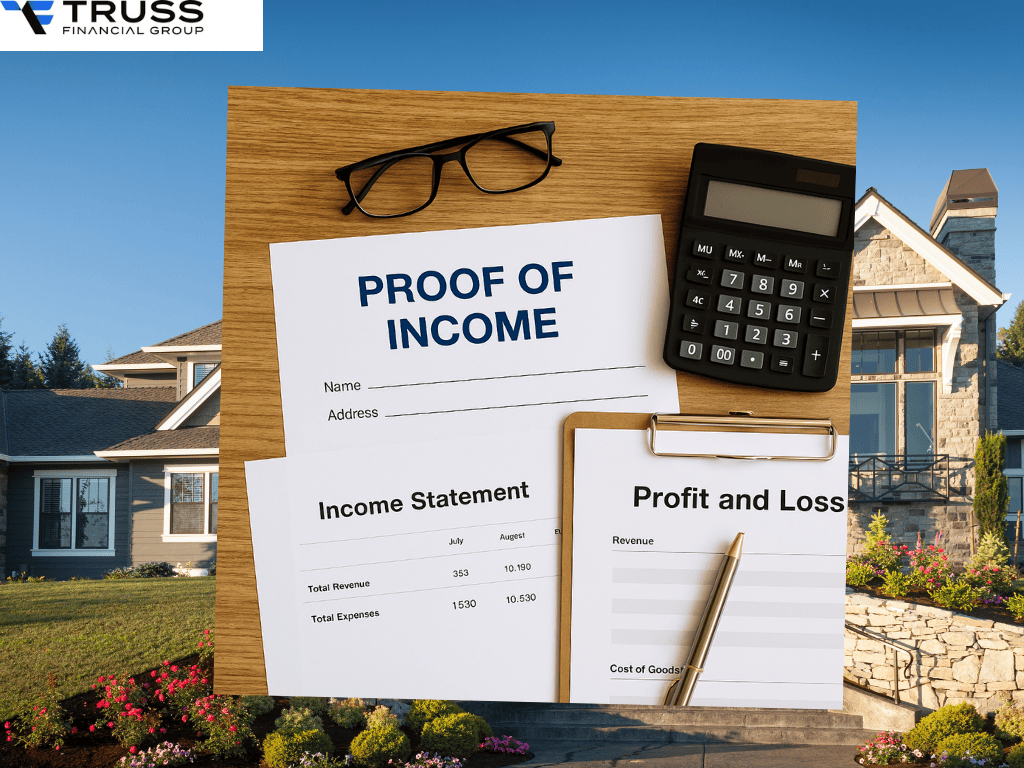7 min read

Proving income as a self-employed professional takes more than a pay stub, it requires organization and documentation.
Whether applying for a mortgage, rental, or insurance, you’ll need clear proof that your income is steady and legitimate.
Essential Documents:
-
Tax returns: Show annual income and business expenses (keep at least two years).
-
Profit & Loss statements: Reflect current business performance.
-
Bank statements: Verify deposits and cash flow.
-
Invoices & contracts: Demonstrate consistent work and active clients.
Keeping accurate, up-to-date financial record using accounting software and separate business accounts, helps strengthen your case.
Even if your income fluctuates, consistent documentation builds trust with lenders and landlords.
For personalized guidance and smarter financial planning, contact Truss Financial Group to simplify your self-employment income verification process.
Being your own boss offers freedom, flexibility, and opportunity but it also comes with extra paperwork. If you’re trying to figure out how to show proof of income when self-employed, whether for a mortgage, rental application, or subsidized health insurance, you’ll need to prove your income in ways traditional employees don’t. Since self-employed individuals don’t receive regular pay stubs, they must rely on other documents to verify business income, expenses, and overall financial situation.
This guide walks you through the most effective ways to document and demonstrate your self-employment income: from tax returns and bank statements to profit and loss statements and beyond.
Need help navigating your financial path? Contact us for expert assistance.
Why Proof of Income Matters When You’re Self Employed
If you’re running your own business, showing proof of income is crucial for any financial milestone whether you’re applying for a loan, securing rental properties, qualifying for health insurance, or preparing for tax time. Unlike salaried workers who receive regular pay stubs, you’ll need to piece together your self employed income from different types of records.

These include:
-
Income tax returns (annual)
-
Profit and loss statements (monthly/quarterly)
-
Bank statements from a business bank account
-
Invoices, contracts, or client letters
Showing consistent income, even without a fixed salary, helps verify that your earnings are reliable and your business is sustainable.
Understanding Self Employment Income Requirements
Financial institutions, landlords, and government agencies want a full view of your income not just how much you make, but how steady and verifiable it is. They’ll look at:
-
Business expenses and profit margins
-
Revenue trends
-
Legal proof of business operations, like your business start date or registration
The more organized your income documentation, the easier it is to get approved for loans, leases, or public benefits.
Key Documents to Prove Self Employed Income
Let’s break down the essential proof of income documents that most institutions require:

1. Income Tax Returns
Your annual tax returns are often the most trusted record of your self employment income. They include:
-
Total income earned
-
Declared business expenses
-
Calculated net income
Keep at least two years of filed tax returns on hand for all official applications.
2. Profit and Loss (P&L) Statements
A profit and loss statement shows:
-
Your revenue during a specific period
-
Your expenses
-
Final profit (or loss)
Many lenders ask for a year-to-date profit statement to assess how your business is currently performing.
3. Bank Statements
Your business bank account helps verify income through:
-
Business-related deposits
-
Outgoing transactions
-
Patterns in cash flow
Using online banking or a dedicated business checking account keeps your income trail clear.
4. Invoices and Contracts
Current and past invoices or service contracts show active work and future income. They add legitimacy to your claimed earnings and demonstrate consistent business activity.
5. Other Supporting Documents
Depending on your application, you may also need:
-
Client letters confirming contract work
-
A current business license or DBA registration
-
A breakdown of hours worked or pay per project
Having these ready shows professionalism and simplifies income verification.
Keeping Financial Records Organized
Strong financial record-keeping is your best tool for proving income. Here’s how to stay organized:
-
Use accounting software (QuickBooks, FreshBooks, Wave, etc.)
-
Maintain up-to-date profit and loss statements
-
Keep a digital and physical copy of all business transactions
-
Reconcile accounts regularly to catch errors
Accurate documentation ensures that your numbers add up when it’s time to apply for a mortgage, file taxes or report self-employment income to any financial institution.
Working with a Financial Institution
Establishing a relationship with a financial institution isn’t just smart, it can help you access more tools and support for documenting your income. Here are a few best practices:
-
Open a separate business account (never mix personal and business finances)
-
Stick to a regular pay period for your personal income draw
-
Request detailed monthly bank statements that highlight business income
These habits help create a clearer picture of your income and show that your business finances are well managed.

Reporting Income Accurately with Tax Returns
Your income tax returns are foundational. For Canadian residents, the CRA expects all self employed people to:
-
Report gross income and business expenses honestly
-
Maintain supporting documents for each pay period
-
Accurately declare net income to determine eligibility for credits or insurance
Working with a tax professional can help ensure compliance and identify opportunities to optimize your filings.
Using Loss Statements to Support Your Case
Even if your business had a slow year, a well-prepared loss statement can still help. It shows:
-
Your business is legitimate
-
You understand your financial situation
-
You’re actively tracking income and business expenses
In some cases, loss statements may improve your standing with lenders by demonstrating responsible financial management.
Verifying Income Through Bank Activity
Here’s how bank statements can work for income proof:
-
Reflect self employed income via regular deposits
-
Differentiate between personal and business expenses
-
Back up the figures reported in your tax return or P&L statement
Using a business checking account for all transactions not only simplifies reporting but builds trust with whoever is reviewing your application.
FAQs: Self Employed Income Documentation
How do I get my pay stubs if I’m self-employed?
You won’t receive traditional pay stubs, but you can generate equivalents using P&L statements, invoices, and bank statements.
What’s the easiest way to show proof of income?
Use a trio of documents: tax returns, profit and loss statements, and bank statements.
How do I report income for self-employment?
Declare all income and expenses on your annual tax return and keep receipts for validation.
What if I don’t have a job?
If you’re self-employed, use your financial records. If you’re not earning, you may need to show other documents like a support affidavit or unemployment documentation.
Final Thoughts
If you’re self employed, learning how to show proof of income is one of the smartest moves you can make. Whether you’re applying for a mortgage, securing a lease, or qualifying for subsidized health insurance, your ability to document self employment income matters.
Keep accurate income statements, file your tax returns properly, and maintain clean bank records. Better documentation means faster approvals and greater financial access.
Need help preparing your documents? Reach out to Truss Financial Group and let’s move your goals forward together.
Table of Content

Take your pick of loans
Experience a clear, stress-free loan process with personalized service and expert guidance.
Get a quote


